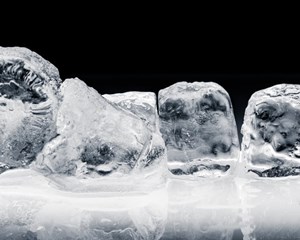The ice in your drink comes from one of two places: your freezer, or someone else's. For homemade ice, the supply chain is reassuringly familiar: water goes into the freezer, and a bit later, ice comes out. But what about the ice cubes that you bought from a supermarket, or extracted, by the handful, from a plastic bag at a drinks party? They were frozen when you took possession of them; they are long gone now. Where did they start out, back when they were water?
飲料中的冰塊來自兩個地方:你的冰箱,或者別人的冰箱。對于自制冰塊來說,其供應鏈是令人放心的:水進入冰箱,過一會兒,冰塊就出來了。但是,你從超市買來的冰塊,或者在酒會上從塑料袋里一把一把取出來的冰塊來自哪里呢?當你拿到它們的時候它們已經凍好了,現在它們早已消失。它們是從哪里開始的,當它們還是水的時候?
Follow their journey all the way back from the point of sale – through warehouses and depots and cold storage facilities and innumerable temperature-controlled lorries – and there's a decent chance that most of them came from the same place: an industrial estate just outside South Kirkby in West Yorkshire. The company that made them is called The Ice Co, and if you haven't heard of it, you have almost certainly used its products.
我們從銷售點開始,一路全程追蹤:經過一個又一個倉庫、冷藏設施和無數的溫度控制卡車——大部分的冰塊很有可能來自同一個地方:即西約克郡南柯比郊外的一個工業區。生產這些冰塊的公司叫The Ice Co,就算你沒有聽說過它的大名,但幾乎可以肯定的是,你用過它的產品。

If you have grabbed a bag of ice from the freezer of a corner shop on a hot day, The Ice Co probably supplied it. If you have bought ice from Tesco, Sainsbury's, Waitrose, Morrisons or Ocado, The Ice Co thanks you for your business. If you have ever plonked a bottle of prosecco into a house party ice bucket filled with cylindrical cubes, or pulled a cold can of Coke from the chilling bins at Glastonbury, or – indeed – endured the Arctic Enema ice bath obstacle at a Tough Mudder endurance course, it is highly likely that the ice originated in The Ice Co's ice factory, a long, flat building nestled in the countryside between Doncaster and Leeds.
如果你在一個大熱天從街角商店的冰箱里拿了一袋冰,它很有可能來自The Ice Co公司。如果你在特斯科、森寶利、維特羅斯、莫里森或者奧凱多(均為英國商超)購買過冰塊,The Ice Co公司感謝您的惠顧。如果你曾經把一瓶普羅賽克葡萄酒倒入滿是圓柱形冰塊的家庭聚會冰桶中,或者從格拉斯頓伯里音樂節的冰柜里拿出一罐冰鎮可樂,或者在一次“最強泥人”耐力賽中忍受了冰浴的障礙,這些冰很有可能都來自The Ice Co的制冰廠,那是一棟長而扁平的建筑,坐落在唐卡斯特和利茲之間的一個鄉村。
Like central heating and hot water, ice is one of those minor luxuries we scarcely think to notice. And yet The Ice Co has turned frozen water into a 38m pound brand – at a retail price of roughly 1 pound a bag, that equates to plenty of people indulging every year.
就像中央暖氣和熱水一樣,冰塊是我們幾乎不會注意到的小奢侈品之一。然而,The Ice Co公司已經將冷凍水變成了市值3800萬英鎊的品牌——零售價大約是每袋1英鎊,這告訴我們每年都有很多人為其買單。
It is perhaps surprising that there is even a market for packaged ice in the UK – let alone one that requires The Ice Co to produce 400 tonnes of the stuff per day, or 5bn cubes per year. We do not lack the specialised equipment required to make our own ice: 98% of British homes contain some form of freezer. We do not, as a rule, have issues with our drinking water, so freezing our own in plastic or silicone trays is not unsafe. While British summers can be warm, they are nothing like summer in the southern US's so-called Sun Belt, the modern ice trade's heartland, where the largest operators produce over 1bn cubes a day. We do not, strictly speaking, even need ice in our drinks – no one does! – which means that we must have acquired a taste for it; so much so, over the years, that we are now willing to pay for the privilege.
或許令人驚訝的是,英國竟然有一個包裝冰的市場——更不用說一個需要Ice Co每天生產400噸或每年50立方的市場了。我們并不缺乏自制冰塊所需的特殊設備:98%的英國家庭都有某種冰箱。我們的飲用水一般來說沒有問題,所以我們把自己家的水放在塑料或硅膠托盤里冷凍并非不安全。英國的夏天可能很暖和,但和美國南部所謂的“陽光地帶”的夏天截然不同。“陽光地帶”是現代冰貿易的中心地帶,在那里,最大的冰商每天能生產10億立方冰塊。嚴格地說,我們并不需要在飲料里加冰塊——沒有人需要!——這說明我們一定是已經嘗到了它的某種味道,以致于這么多年來已經愿意為這個特權付錢。











